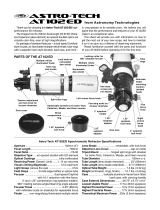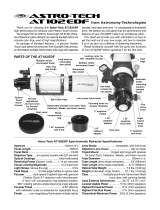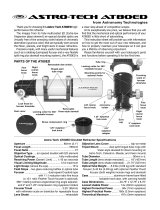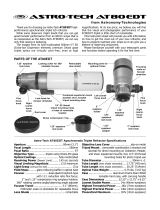Page is loading ...

Instruction Manual for the VSD100F3.8

To begin with
Thank you for your purchase of a Vixen VSD100F3.8 refracting telescope.
This manual describes the VSD100F3.8 optical tube assembly. Read the instructions for your mount along with this manual
if you purchased the telescope as a complete package.
Never look directly at the sun with the telescope or its finder scope or eyepiece. Permanent and irreversible
eye damage may result.
Warning
Caution
This instruction manual will assist you in the safe and effective use of the VSD100F3.8 optical tube. Please follow the
instructions precisely.
Be sure to read the instructions carefully before use.
If misused, it can cause you a serous injury or death.
Misuse can cause injury or damage to other property.
Legend
Important
Direction
You must complete all of the steps in this manual.
You must completely execute the instructions in this manual.
Legend
Warning
Do not leave the optical tube uncapped in the daytime. Sunlight passing through the telescope or finder scope may cause a fire.
Do not use the product while moving or walking, injuries could result from a collision with objects or from stumbling or falling.
Keep small caps, plastic bags or plastic packing materials away from children. These may cause choking or suffocation.
Caution
2

Handling and Storage
Do not leave the product inside a car in bright sunshine or in other
hot places. Keep any strong heat sources away from the product.
When cleaning the body, do not use solvents such as paint thinner
or similar products.
Do not expose the product to rain, water, dirt or sand.
For storage keep the product in a dry place and do not expose to
direct sunlight.
Blow off dust on lenses using a commercially available blower
brush.
Avoid touching any lens surfaces directly with your hands. In
case a lens becomes dirty with fingerprints or general smears,
gently wipe it using a commercially available lens cleaner and a
lens cleaning paper or cloth, or consult your local Vixen dealer.
Be sure to touch the lens surface with the most care to prevent it
from scratching by accident.
Contents
To begin with
------------------------------------------------------ P 2
--------------------------------------------------------- P 2
-------------------------------------------- P 3
---------------------------------------- P 4
------ P 2
Be sure to read the instructions carefully before use
Warning
Handling and Storage
-------------------------------------------------------- P 4
Description
Setting up the Telescope
Reproduction of a Point in Focus
------------------------------ P 7
1. Attaching the Telescope to the Mount
2. Attaching the Finder Scope
3. Focusing the Telescope
4. Reading the Graduations on the Focus Ring
About the Vernier Scale
--------------------------- P 4
--------------------------------------- P 5
------------------------------------------- P 5
------------------- P 6
---------------------------------------------- P 6
Photographic Components Guide
(Prime Focus Photography)
Photographic Components Guide
(Eyepiece Projection Photography, Afocal Imaging Photography)
Visual Observing Components Guide
Filter Attachment
----------------------------------- P 7
----------------------------------- P 8
------------------------------ P 9
------------------------------------------------------ P 9
Focuser Squaring Adjustments
-------------------------------- P10
Specifications
---------------------------------------------------- P11
3

Description
Dew Shield
Optical Tube
Drawtube Lock Screw
Vernier Scale
Graduation on the Drawtube
Focus Ring
Focus Ring Lock Screw
Ring D
Ring E
Ring C
Ring B
Ring A
Eyepiece set screw
Finder Bracket Attachment Base
Setting up the Telescope
The SX tube ring 115mm does not fit the VSD100F3.8 OTA. (Refer to your mount instructions along with this manual.
1.Attaching the Telescope to the Mount (A dedicated tube ring 115mm unit for VSD is required.)
4

Loosen the drawtube lock screw and
turn the focus ring on the precision
helical focuser. This allows you to
move the drawtube back and forth in
small increments.
2. Attaching the Finder Scope
3. Focusing the Telescope
Attach the optional finder scope
bracket shoe to the attachment base
on the VSD100F3.8 with a bolt. The
bolt is supplied with the finder scope
bracket shoe.
Slide the 7x50 finder scope with the
bracket into the finder scope bracket
shoe as shown in the diagram.
Tighten the finder scope bracket lock
screw to secure the 7x50 finder
scope in place.
Finder Bracket
Fixing Screw
Drawtube Lock Screw
Drawtube
Focus Ring
5

(1) Read the value of the graduation where the zero point on the vernier scale indicates.
(2) Read the value of the graduation where the two lines are aligned straight on both the graduation on the focus ring
and the vernier scale.
(3) Put the above two values together to get a total.
(1) The line of zero point on the vernier
scale is aligned straight to the line of
24 on the graduations of the focus ring.
(2) The line of 0.2 on the vernier scale is
aligned straight to a line on the
graduation of the focus ring. The value
can be read as 0.00.
(3) The total value is 24 + 0.00 = 24.00
(1) The line of zero point on the vernier scale
indicates a middle place between the
lines 24 and 24.2 on the graduations of
the focus ring.
(2) The line of 0.1 on the vernier scale is
aligned straight to a line on the
graduation of the focus ring. The value
can be read as 0.10.
(3) The total value is 24 + 0.10 = 24.10
(1) The line of zero point on the vernier scale
indicates a place between the lines 24
and 24.2 on the graduations of the focus
ring.
(2) The line of 0.14 on the vernier scale is
aligned straight to a line on the
graduation of the focus ring. The value
can be read as 0.14.
(3) The total value is 24 + 0.14 = 24.14
The vernier scale does not correspond with the zero point on the focuser drawtube.
The vernier scale can read the amount of drawing the tube in/out up to 0.02mm but the position of focus shifts
according to environmental temperature where the VSD100F3.8 is used. When the drawtube is drawn in to the end,
the vernier scale may not come to an end at zero point because of this effect. Therefore, the vernier scale on the
VSD100F3.8 is designed to go across the zero point.
4. Reading the Graduations on the Focus Ring
About the Vernier Scale
The travel of the focuser drawtube to a focal point varies with environmental temperature. Recording the readout of
the vernier scale and the corresponding temperature will be helpful in setting the focus next time. It is recommended
that you turn the focus ring in the same direction when you reproduce the focal point with the vernier scale.
Reproduction of a Point in Focus
Example 1: A total value is 24mm Example 2: A total value is 24.10mm Example 3: A total value is 24.14mm
Drawtube 0.02mm Increments
Vernier 0.02mm Increments
Example 1 Example 2 Example 3
6

Ring D
Ring C
Ring B
58mm Filter
(Sold Commercially)
Focus Ring
Lock Screw
Prime Focus Wide Adapter 60
58mm Filter
(Sold Commercially)
(D)SLR Camera
PENTAX 645D
Camera Body
Camera mount adapter
PENTAX 645D
(D)SLR Camera
T-Ring (Appropriate to your camera.)
T-Ring (Appropriate to your camera.)
Photographic Components Guide
Prime Focus Photography
T Ring for C Mount Monitor / TVCCD
Camera
7

Ring D Ring C
Ring B
Eyepiece set screw
Ring A
58mm Filter
(Sold Commercially)
Eyepiece Projection Photography, Afocal Imaging Photography
Focus Ring Lock Screw
Eyepiece
(31.7mm)
Eyepiece Adapter
(42mmT to 31.7mm)
Compact Digital Camera
/ Digital Video Camera
Mobile Phone
Camera
Smart Phone
Camera
Universal Digital Camera Adapter II
Mobile Phone Digiscoping Adapter
(Supplied with UDCA II)
(D)SLR
Camera
T-Ring
(Appropriate
to your camera.)
Eyepiece Projection Camera Adapter
8

Ring D
Ring C
Ring B Eyepiece set screw
Ring A
58mm Filter
(Sold Commercially)
Visual Observing Components Guide
Filter Attachment
Eyepiece
(31.7mm)
Eyepiece
(50.8mm)
Focus Ring Lock Screw
Ring D
Ring C
Ring B
Ring A
58mm Filter (Sold Commercially)
EA42mmT to 50.8mm
(Vignetting may occur)
Focus Ring Lock Screw
Commercially available 58mm filters can be screwed onto the top of the ring C.
The filters may cause ghost images in photography.
9

Ring E
Pull Screw
Push Screw
Ring D
Necessity of the focuser squaring adjustments
Focuser Squaring Adjustments
• There is a set of six adjustment screws on the D ring and E ring
respectively which are placed at even intervals.
• The adjustment screws on the D ring work as push screws and the
ones on the E ring work as pull screws.
• The squaring adjustments can be done with the supplied Allen key
(1. 5mm).
• Choose a set of any three of the six push screws at 120 degrees
apart on the D ring for the adjustments. Loosen a set of the
remaining three push screws in advance as they are used along
with adjustment screws.
• Slightly loosen two push screws on the side you want to bring
toward you and tighten the corresponding two pull screws.
• After the squaring adjustments finish, tighten the set of the three
supportive adjustment screws lightly.
Caution
How to return the focuser position to the factory default
Loosening all the push screws and then tightening all the pull screws will bring the focuser position to the initial setting at the Vixen’s factory.
The VSD100F3.8 produces a very flat focal plane that can detect a subtle misalignment of the mount* of a camera used. The resulting image
will not be sharp on part of the focal plane if you use a medium size camera with a large imaging sensor like 645D format. *It is within the
tolerance of the specifications.
Be sure to read this complete page before you make these adjustments.
The focuser squaring adjustments are subject to your clear understanding and acceptance of the following:
(1) To secure the focuser squaring adjustments, the camera must be attached to the focuser in the same position and orientation as it was
attached to the focuser at the squaring adjustments; otherwise, the image will not be entirely sharp.
(2) To secure the focuser square adjustments, a rotation of the imaging frame must be done by rotating the whole optical tube. A rotation of the
imaging frame with the camera adapter ring only will produce an image that is not completely sharp.
(3) To secure the focuser squaring adjustments, the same camera should be used with the optical tube for astrophotography. Attaching a
different camera to the optical tube will require the focuser squaring adjustments be performed again with the camera being used.
(1) The focuser squaring adjustments are set at Vixen’s factory and re-adjustments of this part are not generally needed. The focuser squaring
adjustment described here is a highly technical method designed for professionals and experienced amateurs who have ample knowledge of
complex technology and equipment for astro-imaging with a large format imaging sensor. Never touch this part if you are not comfortable
with complex technology.
(2) Vixen does not provide details or endorse your adjustment of the focuser squaring. It is the users responsibility for the focuser squaring
adjustments if you proceed with the adjustments.
10

116
Back focus
140
130
115
163
89
153
89
M112 x 1
Filter thread
M84x1
M58x0.75
Filter thread
60.2
M60x0.75
M42x0.75
T ring thread
Ring A
Ring B
Ring C
Ring D
Ring E
M6x1 Depth 9
M8x1.25 Depth 10
unit : mm
Copyright(C) 2013 Vixen Co.,Ltd. All Rights Reserved.
31.7
Sp e cific at ions
Objective lens design
Effective aperture
Focal length
Focal ratio
Light gathering power
Resolving power
Limiting magnitude
Image circle
Drawtube diameter
Adapter threads dia
Push-fit
Filter threads dia
Optical tube length
Optical tube diameter
Optical tube weight
Accessories
Optional accessories
Objective lens
Focuser
Size & weight
Others
: SD Apochromatic, fully AS coatings, 5-group 5-element design(SD lens x 1, ED lens x 1)
: 100mm
: 380mm
: F/3.8
: 204x unaided eye
: 1.16 ar c s ec o nd s
: 11. 8
: 70mm, about 60% illumination at the edge (covering 645 format)
: 89mm
: M84-pitch 1mm, M60-pitch 0.75mm, M42-pitch 0.75mm
: 60.2mm, 31.7mm
: 58mm
: 497mm
: 115mm (*SX tube ring 115mm is not compatible with VSD100F3.8.)
: 4.5 kg
: Aluminum case, Allen key 1.5mm
: VSD Tube ring115mm, Finder bracket shoe, Camera mounting adapter for 645D,
VSD Focal Extender 1.58x, VSD Focal Reducer 0.79x
VSD100F3.8 Model
11

61キ-1-0.01S-(DC1450GA)(M)
5-17-3 H igash itokorozawa,Tokorozawa, Saitama 359-0021, Japan
Phone +81-4-2944-4141
(
International
)
F a x +81-4-2944-9722
(
International
)
http://www.vixen.co.j p
/





